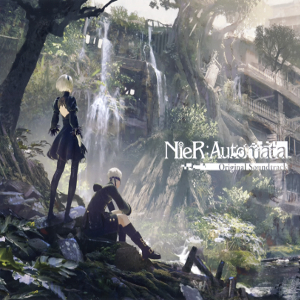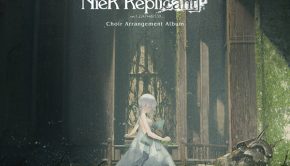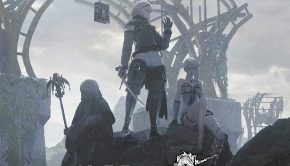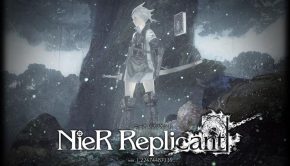NieR:Automata Original Soundtrack
 |
Album Title: NieR:Automata Original Soundtrack |
| Record Label: Square Enix |
|
| Catalog No.: SQEX-10589~91 |
|
| Release Date: March 29, 2017 |
|
| Purchase: Buy at CDJapan |
Overview
It’s still hard to believe that 7 years after the first NieR, that we were getting a sequel, given that the game wasn’t a critical smash hit, but one thing that did stand out was the music by Keiichi Okabe and his team (Keigo Hoashi, Kakeru Ishihama) at MONACA. It was generally well-regarded and really accentuated the atmosphere of the game. I can only imagine the pressure that they felt when composing the soundtrack for this game, as they certainly had big shoes to fill. Okabe and Hoashi return and this time are joined by Kuniyuki Takahashi, who debuted in the world of game music with his work on Drag-on Dragoon 3, also directed by Yoko Taro. Does their sequel live up to the lofty expectations set by fans of the original soundtrack?
Body
The album opens up with the first title screen music, “Significance – Nothing,” featuring an atmospheric backing track, piano, subtle vocal usage, and some electronic elements. It immediately tells you that, at least to some degree, the music in this game will have some differences compared to the original. The second title screen music, simply “Significance,” features a richer sound, a slightly more prominent use of vocals, although quite subtle compared to the other vocals on the album, and continues with the piano as well. Another such tune, “The Color of Depression,” is tense, darker, and features some industrial tones, while “Widespread Illness” adds some ethereal synth, but is largely forgettable. Slightly better is “Fortress of Lies,” which provides a similar electronic ambiance, but has an atmosphere that is certainly more beautiful than other purely electronic tunes on the album. However, overall, I feel that the more atmospheric tracks are an afterthought and while they work well in the context of the game, fail to stand out when listened to in isolation.
Of course, there are some fan favorites that return with new arrangements. Both “Faltering Prayer ~ Dawn Breeze” and “Faltering Prayer ~ Starry Sky” prominently feature the melody in “Dispossession” from the first NieR soundtrack with the former featuring atmospheric synth, piano, and vocals by Emi Evans that give it a haunting touch while the latter is more melancholic due to the music box rendition. “Grandma ~ Destruction” takes the poignant original and adds a dramatic flair to it by incorporating choir, forgoing the original vocals, however, due to how it is mixed on the soundtrack, when the vocal aspects are removed, it lacks the impact and power the choir brings in. Similarly, “Song of the Ancients ~ Atonement” is reminiscent to “Song of the Ancients ~ Fate” from the first soundtrack, although less rich in sound. The strings accompaniment on this tune also is a bit lacking. The melody itself still works as well as it does in the original, thanks to the retention of the original vocals, but like the arrangement of “Grandma,” when the vocals are removed, the tune itself becomes much less powerful. On the flip side, “Emil ~ Despair,” is similar in style to “Grandma,” but the power is kept a bit better throughout the tune, even when absent vocals.
Many of the area themes also incorporate vocals and capture the essence of the area fairly well. “City Ruins – Rays of Light-” features acoustic guitar, piano, and progresses from a softer sound to a more dynamic and lush arrangement featuring vocals by J’Nique Nicole. The overall atmosphere has a haunting quality to it, befitting for a ruined civilization. These elements are also present in “City Ruins – Shade-,” which features a richer, yet solemn, sound, vocals by Emi Evans, and is a bit more engaging overall. The same dynamic flow is also incorporated as the piece progresses. “Wretched Weaponry” is actually split into two separate tracks, as opposed to fitting all 3 versions into one theme. The first “Wretched Weaponry: Medium/Dynamic” incorporates the more action oriented renditions. The vocals in this piece are also by Emi Evans and accompany a beautiful melody. The accompaniment itself is a bit simplistic at first, primarily with strings and piano, although there are some light industrial touches as well. As the piece progresses, it becomes a bit more march-like in approach and sounds colder, due to the addition of more industrial elements. The “Quiet” version is a more ambient and piano driven rendition with wispy vocals, although it is more a capella like and is reminiscent of “Wretched Automatons” from the first NieR game.
“Peaceful Sleep” is the theme for a small outpost in the game and this mix features a nice progression displaying the various elements featured in the track. There is evocative vocals by Emi Evans, acoustic guitar, lending a rustic touch to the piece. The piece itself is simple and relaxing, but does lose a bit of its impact when it becomes more instrumental as the melody itself starts to wane. The piece ends with a music box rendition of the theme, which helps bring it back to a more melody focused tune and closes the piece out on a higher note. Another town theme is “Pascal,” which incorporates acoustic elements, clapping, mechanical sound effects, and mallet percussion, in conjunction with a blend of children’s vocals and processed vocals to give a sense of innocence to the piece. The piece itself may not be for everyone, but it does have its own charm. While not exactly an area theme, “Emil’s Shop” is a quirky vocal tune with a march-like approach. Included in this version is the Japanese lyrics and the “gibberish” version. The melody itself is catchy, but the tune itself certainly feels out of place, especially during the gibberish sections, which is unfortunate. In some ways, I wish the English version of the lyrics were included as they add a comedic element that is lost to non-Japanese speakers when listening to this rendition.The desert area theme, “Memories of Dust,” features vocals by J’Nique Nicole and her performance helps give it an exotic flavor and overall is quite powerful. In terms of influence, there is plenty of Middle Eastern instrumentation that helps add to the desert feel of the piece. As the piece moves on, the vocals are replaced by instrumentation, similar to when the game is more exploration and less combat. It’s an interesting progression and one that works, but I feel some of the vocal-less aspects are a bit mediocre.
The forest area theme, “Forest Kingdom,” references “The Incomplete Stone” from NieR and uses as part of the accompaniment. The piece starts out quite calm with piano and ethereal synth before adding similar style vocals by Nakagawa, which helps give the piece a bit of a mysterious air before adding percussion, giving it a bit more dynamism and a richer sound. “Copied City” is a beautiful piano/strings driven piece with ethereal vocals which really capture the atmosphere of the dungeon with its pristine whitewash. There is a bit of a haunting atmosphere to it as well, giving it a bit of a dramatic flair and adding some tension to the mix. Similarly, “The Tower,” is a blend of ethereal, ambient electronic tones featuring both Emi Evans and J’Nique Nicole on vocals, of which the latter adds a very powerful element to counter the softer aspects of Emi Evans’ vocals. As the piece progresses, it gets a bit darker due to the addition of percussion and there is even some 8bit influence utilized in the piece as well. It’s certainly one of my favorite area themes. Speaking of area themes, perhaps the strongest on the album is “Amusement Park.” The piece itself is extremely mysterious, yet playful, with its carnivalesque sound, thanks to the accordion and mallet percussion, and boasts an excellent melody. Beautiful strings and vocals by Emi Evans help add to the piece. Of note is how the piece progresses. It transitions from the more “medium” sounding tempo before transitioning to the softer piano driven section before finally moving onto the more action oriented aspects of the track where there is a much richer sound and where the strings really get a chance to shine and the carnivalesque sound is retained in the accompaniment.
Of course, there are plenty of boss battle themes featured on the album, of which there is a variety, reminiscent of the original game’s soundtrack as well as more unique to the universe. “Birth of a Wish” features male chanting and interesting rhythms while also adding in some Middle Eastern sounds later into the piece to help tie it to the desert area in which it is first played. The piece is reminiscent of “Blu-bird” in style in some ways. Absent from this version is the effects from the game, such as “We Cannot Continue” or the Japanese equivalent, that is constantly played throughout the battle, as it certainly makes the piece more interesting. My absolute favorite battle theme and, subsequently, favorite tune on the soundtrack is “A Beautiful Song,” the boss theme to accompany the enemy found in the Amusement Park area. The piece, which features vocals by all three major vocalists on the soundtrack, is extremely powerful, yet retains a haunting melody nonetheless. Female choir, heavy percussion, and strings blend together to form a fitting backbone for the piece. Perhaps the pinnacle of the track, J’Nique Nicole’s powerful voice gives a mysticism to the piece and certainly packs a punch. It’s an excellent tune fitting for an equally excellent battle.
The “oddball” out in terms of the battle themes is certainly “End of the Unknown,” a heavy electronic piece in the vein of Tekken, of which Okabe has contributed in the past. The vocal samples help give it a nice exotic touch and while it may seem out of place, it fits within the confines of the game, where this battle takes place on a 2D plane, similar to that of a fighting game. The resultant tune is certainly intense, but also features a bit of a catchy melody as well. “Dark Colossus – Kaiju” captures the spirit of “Dark Colossus Destroys All” from the first game by incorporating the more bombastic original, with minimal changes in terms of instrumentation, choir, or melody, although it is certainly more intense in nature. However, the slower organ sections that are incorporated into the piece give it a more sobering tone, giving it a bit of a Castlevania-like or a religious tone. “Dependent Weakling” is one of the more dramatic tunes and serves as the final boss theme in some of the playthroughs. The melody itself is quite haunting, accentuated by the violin and vocals. The end result is certainly enjoyable though and certainly fits with the battle, but lacks some of the impact that “Shadowlord,” which in some ways this mirrors stylistically, had from the first game.
As with the first game, the ending vocal, “Weight of the World” comes in a variety of flavors, each one played during a different ending credits roll. The English version, sung by J’Nique Nicole, is the first rendition you’ll hear in the game. The tune itself features a blend of acoustic guitar, percussion, and strings and boasts an exquisite melody. The atmosphere of the piece itself does have a bit of a Disney-esque pop sound, but the excellent lyrics and powerful performance truly make the piece shine, particularly in the latter half when some powerful variations of the chorus complement the softer aspects of the piece. The Japanese version, “Weight of the World Kowaretasekainouta,” sung by Marina Kawano, adds a wispy element to the piece. The progression of the piece is largely similar, however, whereas J’Nique Nicole’s version offered power and hope, Kawano’s adds a tinge of hopelessness and sadness as the climax of her piece is extremely emotional and has a distraught sound to her vocals. When it comes to the third version, “Weight of the World Nouveau – FR Version,” sung by Emi Evans, the first thing that immediately pops out is the more solemn strings and electronic elements that open the piece, as opposed to the piano in the other two versions. This mirrors the overall performance, where Emi Evans’ vocals have a more melancholic and poignant sound to them and similar in progression, her vocals are highlighted with light accompaniment that help accentuate the overall feel of her performances.
Lastly, “Weight of the World the End of YoRHa,” the music plays for the final ending credits is perhaps the strongest of all versions, if only due to how it is executed. Opening with an 8bit rendition of the piece, it offers a glimpse into some of the gameplay present in the game before moving into the chorus of the English version, sung by J’Nique Nicole. As the piece progresses, vocals by Emi Evans and Marina Kawano are incorporated and all mingle and transition seamlessly with one another. It really ties all of the versions together. In addition, there is also a backing choir which consists of the entire development team, that really manages to add an extra layer of musical texture. Although this version isn’t quite how it plays out in the game, it certainly is an extremely representative way of piecing together all of the elements of the truly progressive and interactive ending credits. In comparing it to “Ashes of Dreams,” it isn’t quite as impactful, but it certainly manages to fit within the game and create an entertaining listen.
Summary
While the NieR:Automata Original Soundtrack is sure to please fans of the original, aspects of this version aren’t as ambitious or as powerful as the original soundtrack. There are certainly high points that surpass the original soundtrack, but they are sometimes countered by pieces that fail to elicit any response when taken out of context. There is still plenty to enjoy on the soundtrack and the vocal forward soundtrack that made NieR shine is still in full force, with additional singers that really manage to add their own flair to the soundtrack. Recommended for fans of the original game’s soundtrack; however, if you weren’t a fan of that soundtrack, there isn’t much to entice you on this one.
Do you agree with the review and score? Let us know in the comments below!
4
Posted on July 25, 2017 by Don Kotowski. Last modified on July 25, 2017.














